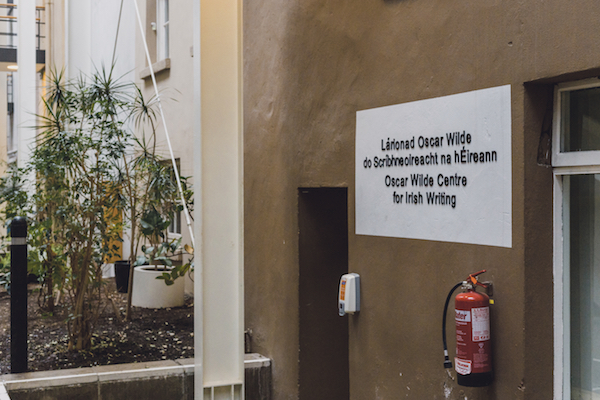
In Richard Ellman’s infamous biography of Oscar Wilde, the address of 21 Westland Row was given a very brief mention: “Oscar Fingal O’Flahertie Wills Wilde, was born on 16th October 1854, when the family was still living at 21 Westland Row, though he always claimed that they had already moved to their better address at 1 Merrion Square.”
Opened in January 1998 as the Oscar Wilde Centre for Irish Writing, the former home now serves the purpose of a teaching and research centre for the postgraduate degree in Irish writing and the degree in creative writing offered by Trinity.
Opened by Gerald Dawe and Brendan Kennelly, it also boasts specialised libraries of writers such as Vivian Mercier and Roy McFadden and hosts the Irish Writer Fellow and Visiting Writer Fellow. Architecturally, it is something quite astonishing: a terraced house dating from the 1830s and 1840s, the house is of a standard period layout with the outdoor facade facing onto Westland Row, yet still nestled in the arms of the extremely modern Hamilton and Biotechnology Buildings, both built in 1993 and completed in 1994.
To enter, one must go through the semi-outdoors Hamilton building, with a Costa to one side and labs overflowing with equipment on the other. Postgraduates, lecturers, poets and writers come and go through the back door of the house, the front door having been saved for the opening of the centre by the Provost or used for wheelchair access. Science undergraduates eat packed lunches in what would have been the former back garden of the home, and buses rattle past the single-glazed windows which gaze out onto Westland Row’s modern-day eateries and the DART Station.
Previously home to everyone from Mary Robinson, Chris Morash and Derek Mahon, it is difficult to imagine a young Wilde darting in and out of the rooms in 21 Westland Row. But, then again.
In spite of this, the centre does give an important glimpse into the early years of Wilde, even if just into the affluence of his family and the extravagance of his formative life. I find it amusing to think that although having had only two children at the time – Wilde’s younger sister was not born yet – Lady “Speranza” and William Wilde felt that their home was too small, and moved to Merrion Square, thus betraying the class minefields of Victorian society. The centre is gargantuan and is comprised of a basement and four floors. The room in which Oscar was born is now the office and William Wilde’s former surgery is now the kitchen. The offices for the resident writers and lecturers are in the top floor former bedrooms and the reading rooms take the places of the old drawing room, sitting room and reception room.
For the cynic, the centre could suggest the inherent commercialisation of our Irish literary figures. Yes, Wilde was born there and yes it faces Sweny’s Chemist, that sold (and is still selling) Leopold Bloom’s infamous lemon soap. And yes, by proxy, it celebrates the life of William Wilde, while also celebrating the place of Ireland in the roots of Wilde’s life, and the poetry of his mother, and the literary home that he was born into. But what really gives this building its importance is the fact that it has been given a new lease of life.
Beyond this, the centre is a symbol of preservation. Protected by the modern arms of science and education, it is a home for the literary, for the writers in Ireland regardless of race or gender or sexuality.






